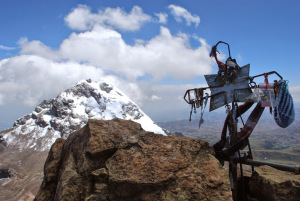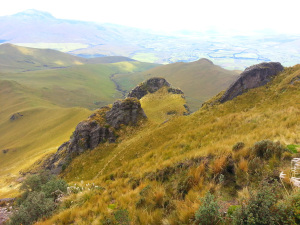
Illiniza North (5126m/16817ft) is the eighth highest in Ecuador. Prehistorically, they were one volcano, but today the two peaks are separated by a saddle of about 1km and less than one mile in width. Both peaks offer some of the more enjoyable climbing in Ecuador and in South America. For the experienced hiker or soft climber, the North peak is a truly fun climb with some heart-stopping scrambles thrown in.
Book Now...

Carihuayrazo is often chosen as an acclimatization climb. Being snow-capped, it offers good possibilities to practice the use of glacier equipment. But there is more about this mountain: It’s situated about 140 kilometers south of Quito and climbing this mountain, you can admire its bigger brother, the Chimborazo, which can be found a bit further in the south. Since there is no refuge we’ll spend the night before the ascent in tents.
Book Now...

You can combine the ascent of this mountain with a visit of the famous Laguna de Cuicocha.
Book Now...

South of Quito you find this extinct volcano, that derives its name from the shape of the northwestern flank, which, seen from the distance, resembles a heart.
Book Now...

Pichincha is an active stratovolcano in the country of Ecuador, whose c
apital Quito wraps around its eastern slopes. The two highest peaks of the mountain are wawa Pichincha (Kichwa wawa child, baby / small, hispanicized spelling Guagua Pichincha) (4,784 metres (15,696 ft)) and Ruku Pichincha (Kichwa ruku old person hispanicized Rucu Pichincha) (4,698 metres (15,413 ft)). The active caldera is in Wawa Pichincha on the western side of the mountain.
Book Now...

Being very close to Quito, Pichincha can be climbed in one day. During all the climb you have a splendid view on the capital.
Book Now...

Situated in the Cotopaxi National Park you can enjoy nice views on the protected area, including the Cotopaxi itself of course.
Book Now...

In the north of the country, near Otavalo and the San Pablo Lake you find this extinct volcano, which is subject of a lot of indigenous legends.
Book Now...

The extinct and eroded volcano retains the distinction to be situated in one of the last regions, where you can find the typical Polilepis trees of the Ecuatorian highlands. With some luck you might even see one of the few remainig majestic Condors flying in the summit and crater area of Pasochoa.
Book Now...